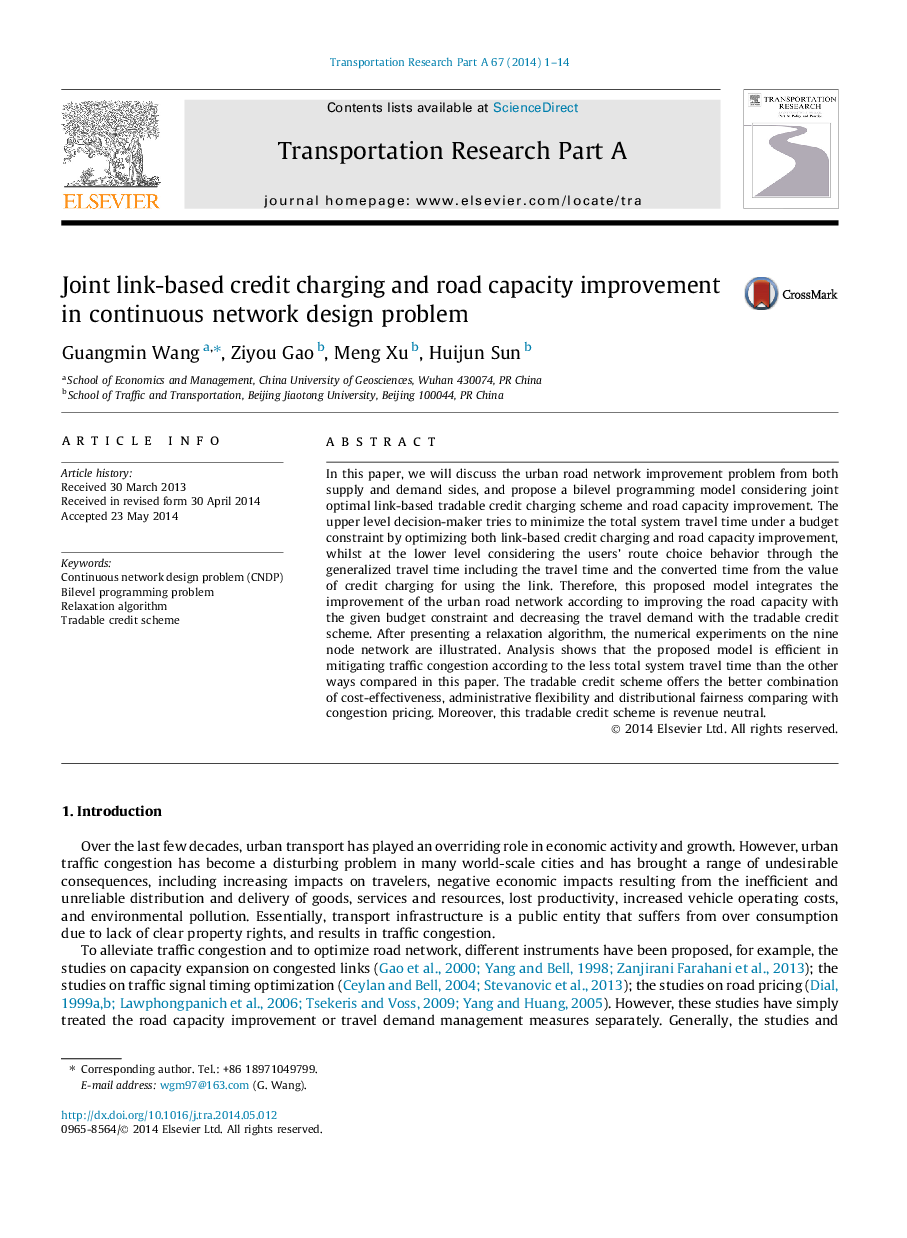| کد مقاله | کد نشریه | سال انتشار | مقاله انگلیسی | نسخه تمام متن |
|---|---|---|---|---|
| 6781602 | 533958 | 2014 | 14 صفحه PDF | دانلود رایگان |
عنوان انگلیسی مقاله ISI
Joint link-based credit charging and road capacity improvement in continuous network design problem
ترجمه فارسی عنوان
شارژ اعتبار مبتنی بر پیوند و افزایش ظرفیت جاده در مشکالت طراحی شبکه مستمر
دانلود مقاله + سفارش ترجمه
دانلود مقاله ISI انگلیسی
رایگان برای ایرانیان
کلمات کلیدی
ترجمه چکیده
در این مقاله، ما در مورد مسائل بهبود شبکه شبکه شهری از طرف دو طرف عرضه و تقاضا بحث خواهیم کرد و پیشنهاد می کنیم یک برنامه برنامه ریزی دو سطر با توجه به طرح شارژ اعتبار قابل اعتبار مبتنی بر پیوند بهینه و بهبود ظرفیت جاده پیشنهاد شود. تصمیم گیرنده سطح بالا تلاش می کند کل زمان سفر سیستم را تحت محدودیت بودجه با بهینه سازی شارژ اعتبار مبتنی بر پیوند و بهبود ظرفیت جاده ها، در حالی که در سطح پایین تر با توجه به رفتار انتخاب مسیر کاربران از طریق زمان سفر عمومی، از جمله زمان سفر و زمان تبدیل از ارزش اعتبار شارژ برای استفاده از لینک. بنابراین، این مدل پیشنهادی، بهبود وضعیت شبکه جادهای شهری را با توجه به بهبود ظرفیت جاده با محدودیت بودجه داده شده و کاهش تقاضای سفر با طرح اعتباری قابل معامله، ادغام می کند. پس از ارائه یک الگوریتم آرام سازی، آزمایش های عددی در شبکه 9 گره نشان داده شده است. تجزیه و تحلیل نشان می دهد که مدل پیشنهادی در کاهش حمل و نقل ترافیکی با توجه به زمان کمتری در زمان سفر سیستم نسبت به روش های دیگر در این مقاله موثر است. طرح اعتباری قابل اعتماد ترجیح می دهد ترکیبی بهتر از اثربخشی هزینه، انعطاف پذیری اداری و منصفانه توزیع شده در مقایسه با قیمت گذاری احتمالی را داشته باشد. علاوه بر این، این طرح اعتباری قابل معامله خالص درآمد است.
موضوعات مرتبط
مهندسی و علوم پایه
سایر رشته های مهندسی
مهندسی عمران و سازه
چکیده انگلیسی
In this paper, we will discuss the urban road network improvement problem from both supply and demand sides, and propose a bilevel programming model considering joint optimal link-based tradable credit charging scheme and road capacity improvement. The upper level decision-maker tries to minimize the total system travel time under a budget constraint by optimizing both link-based credit charging and road capacity improvement, whilst at the lower level considering the users' route choice behavior through the generalized travel time including the travel time and the converted time from the value of credit charging for using the link. Therefore, this proposed model integrates the improvement of the urban road network according to improving the road capacity with the given budget constraint and decreasing the travel demand with the tradable credit scheme. After presenting a relaxation algorithm, the numerical experiments on the nine node network are illustrated. Analysis shows that the proposed model is efficient in mitigating traffic congestion according to the less total system travel time than the other ways compared in this paper. The tradable credit scheme offers the better combination of cost-effectiveness, administrative flexibility and distributional fairness comparing with congestion pricing. Moreover, this tradable credit scheme is revenue neutral.
ناشر
Database: Elsevier - ScienceDirect (ساینس دایرکت)
Journal: Transportation Research Part A: Policy and Practice - Volume 67, September 2014, Pages 1-14
Journal: Transportation Research Part A: Policy and Practice - Volume 67, September 2014, Pages 1-14
نویسندگان
Guangmin Wang, Ziyou Gao, Meng Xu, Huijun Sun,
